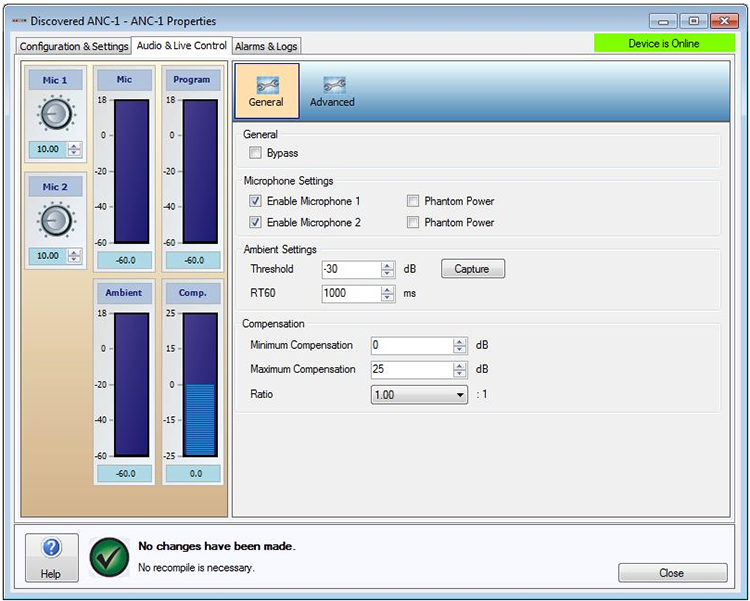
The Audio & Live Control tab is used to make adjustments to the ANC-1 that relate to audio signal processing and control data. The first window is called General and it offers a number of settings that need to be considered for operational setup. Four fields in addition to the Meters are located in the General window: General, Microphone Settings, Ambient Settings, and Compensation. There is also an ANC-1 Audio & Live Control Advanced settings tab where further, more advanced settings can be adjusted. These two dialogs,the Audio & Live Control General and the Audio & Live Control Advanced tabs detail what each function does however please see the ANC Setup Guide for details on actually configuring the ANC-1 for real life applications.
The Mic Meter is provided to display ambient noise, program audio and reverberation as picked up by the ambient microphone. The second meter on the page is the Program Meter, and this shows the program source level that is currently entering the ANC-1. The Ambient Level can be monitored after the program audio and echo is removed with the Ambient Level Meter. The Compensation Meter indicates the amount of gain that the ANC-1 is using to increase or decrease the audio signal. It will fluctuate on either side of the 0 dB mark depending on whether the ANC-1 is applying or reducing gain. If no gain is being applied, the meter will remain at 0dB. Also found in this field are the Mic Gain pots, which allow individual gain adjustment per microphone input channel.
The Bypass checkbox activates and deactivates the ANC-1.
Checkboxes are provided to Enable the microphones and also to toggle Phantom Power on/off. Phantom Power should not be applied to microphones that do not require it as damage may occur.
The Threshold text box is used to set a value in dB that must be exceeded for compensation to take place. The RT60 field is provided for the system designer to specify the RT60 time of the acoustical space that the ANC-1 will be affecting. RT60 is a measurement of how long it takes a sound to decay 60dB in an acoustical space and is used to calculate reverb decay time. The default setting is 1000ms however a large concert hall would typically use a value of around 2000ms and an empty convention center around 5000ms.
The Maximum Compensation text box is used to enter a value in dB, which is used by the Vocia system to determine the maximum amount of gain that can be applied to the program signal once the compensation level has been reached. The Minimum Compensation text box is used to set the minimum gain applied to the program signal. The Ratio dropdown box is used to specify the ratio with which the ANC-1 adjusts program gain in relation to ambient level, once the compensation threshold has been exceeded. This value is selectable in .25 increments.
